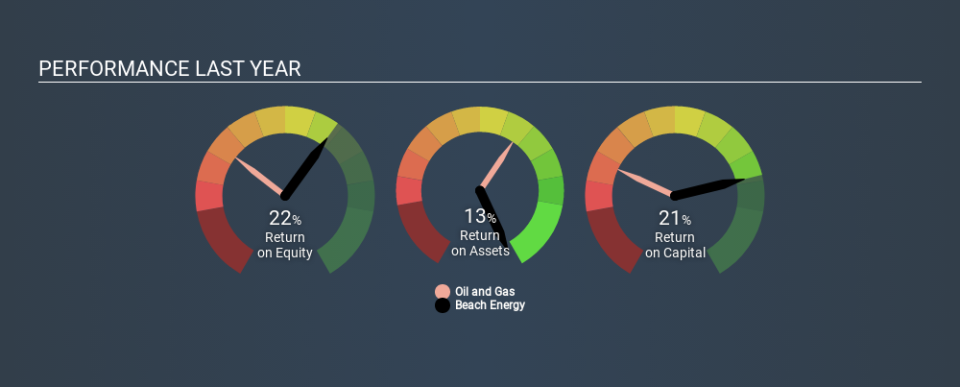Why You Should Like Beach Energy Limited’s (ASX:BPT) ROCE

Today we'll look at Beach Energy Limited (ASX:BPT) and reflect on its potential as an investment. To be precise, we'll consider its Return On Capital Employed (ROCE), as that will inform our view of the quality of the business.
Firstly, we'll go over how we calculate ROCE. Then we'll compare its ROCE to similar companies. Last but not least, we'll look at what impact its current liabilities have on its ROCE.
Return On Capital Employed (ROCE): What is it?
ROCE measures the amount of pre-tax profits a company can generate from the capital employed in its business. All else being equal, a better business will have a higher ROCE. Ultimately, it is a useful but imperfect metric. Renowned investment researcher Michael Mauboussin has suggested that a high ROCE can indicate that 'one dollar invested in the company generates value of more than one dollar'.
So, How Do We Calculate ROCE?
Analysts use this formula to calculate return on capital employed:
Return on Capital Employed = Earnings Before Interest and Tax (EBIT) ÷ (Total Assets - Current Liabilities)
Or for Beach Energy:
0.21 = AU$773m ÷ (AU$4.2b - AU$519m) (Based on the trailing twelve months to December 2019.)
So, Beach Energy has an ROCE of 21%.
Check out our latest analysis for Beach Energy
Does Beach Energy Have A Good ROCE?
ROCE can be useful when making comparisons, such as between similar companies. In our analysis, Beach Energy's ROCE is meaningfully higher than the 7.4% average in the Oil and Gas industry. We would consider this a positive, as it suggests it is using capital more effectively than other similar companies. Putting aside its position relative to its industry for now, in absolute terms, Beach Energy's ROCE is currently very good.
Our data shows that Beach Energy currently has an ROCE of 21%, compared to its ROCE of 4.2% 3 years ago. This makes us think about whether the company has been reinvesting shrewdly. You can see in the image below how Beach Energy's ROCE compares to its industry. Click to see more on past growth.
When considering ROCE, bear in mind that it reflects the past and does not necessarily predict the future. ROCE can be misleading for companies in cyclical industries, with returns looking impressive during the boom times, but very weak during the busts. ROCE is only a point-in-time measure. Given the industry it operates in, Beach Energy could be considered cyclical. Future performance is what matters, and you can see analyst predictions in our free report on analyst forecasts for the company.
What Are Current Liabilities, And How Do They Affect Beach Energy's ROCE?
Liabilities, such as supplier bills and bank overdrafts, are referred to as current liabilities if they need to be paid within 12 months. Due to the way ROCE is calculated, a high level of current liabilities makes a company look as though it has less capital employed, and thus can (sometimes unfairly) boost the ROCE. To counteract this, we check if a company has high current liabilities, relative to its total assets.
Beach Energy has total assets of AU$4.2b and current liabilities of AU$519m. Therefore its current liabilities are equivalent to approximately 12% of its total assets. This is quite a low level of current liabilities which would not greatly boost the already high ROCE.
The Bottom Line On Beach Energy's ROCE
This is good to see, and with such a high ROCE, Beach Energy may be worth a closer look. There might be better investments than Beach Energy out there, but you will have to work hard to find them . These promising businesses with rapidly growing earnings might be right up your alley.
Beach Energy is not the only stock insiders are buying. So take a peek at this free list of growing companies with insider buying.
Love or hate this article? Concerned about the content? Get in touch with us directly. Alternatively, email editorial-team@simplywallst.com.
This article by Simply Wall St is general in nature. It does not constitute a recommendation to buy or sell any stock, and does not take account of your objectives, or your financial situation. We aim to bring you long-term focused analysis driven by fundamental data. Note that our analysis may not factor in the latest price-sensitive company announcements or qualitative material. Simply Wall St has no position in any stocks mentioned. Thank you for reading.

 Yahoo Finance
Yahoo Finance 
